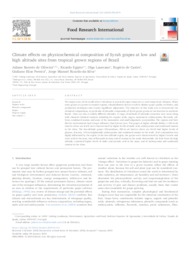Climate effects on physicochemical composition of Syrah grapes at low and high altitude sites from tropical grown regions of Brazil.
Climate effects on physicochemical composition of Syrah grapes at low and high altitude sites from tropical grown regions of Brazil.
Autoria: OLIVEIRA, J. B. de; EGIPTO, R.; LAUREANO, O.; CASTRO, R. de; PEREIRA, G. E.; RICARDO-DA-SILVA, J. M.
Resumo: The major areas of the world where viticulture is practiced enjoy temperate or cool temperature climates. When wine grapes are grown in tropical regions, edaphoclimatic factors result in distinct grape quality attributes, and production techniques also require significant adjustment. The objective of this study was to characterize the chemical compositions, in particular of phenolic compounds, of Syrah grapes grown in two location in northeast Brazil - these are also at widely different altitudes. A range of methods of phenolic extraction were used, along with classical chemical analyses including for organic acids, sugars, monomeric anthocyanins, flavonols, stilbene, condensed tannins and some of the monomeric and small oligomeric procyanidins. The regions and their diverse environments had a larger influence than harvest year. The grapes at higher altitude (Bahia, 1.100 m asl (metres above sea level) were characterized by higher levels of malic acid, anthocyanins and condensed tannins in the skins. The low-altitude grapes (Pernambuco, 350 m asl (metres above sea level) had higher levels of glucose, fructose, 3-O-acetylglucoside anthocyanins and condensed tannins in the seeds. Fruit composition was highly influenced by the region. In the low-altitude region, the grapes were characterized by higher tartaric and citric acid in the must, also of flavonols in skins and of tannins in the seeds. Meanwhile, the fruit from the high altitude, contained higher levels of malic and succinic acid in the must, and of anthocyanins and condensed tannins in the skins.
Ano de publicação: 2019
Tipo de publicação: Artigo de periódico
Unidade: Embrapa Uva e Vinho
Palavras-chave: Açúcares, Composto Fenólico, Organic acids, Phenolic compounds, Região tropical, Sugars, Tropical region, Uva, Vitis Vinifera, Vitis vinifera L, Ácido Orgânico
Observações
1 - Por padrão são exibidas publicações dos últimos 20 anos. Para encontrar publicações mais antigas, configure o filtro ano de publicação, colocando o ano a partir do qual você deseja encontrar publicações. O filtro está na coluna da esquerda na busca acima.
2 - Para ler algumas publicações da Embrapa (apenas as que estão em formato ePub), é necessário ter, no celular ou computador, um desses softwares gratuitos. Sistemas Android: Google Play Livros; IOS: iBooks; Windows e Linux: software Calibre.
Acesse outras publicações
Acesse a Base de Dados da Pesquisa Agropecuária (BDPA) para consultar o acervo completo das bibliotecas da Embrapa.

